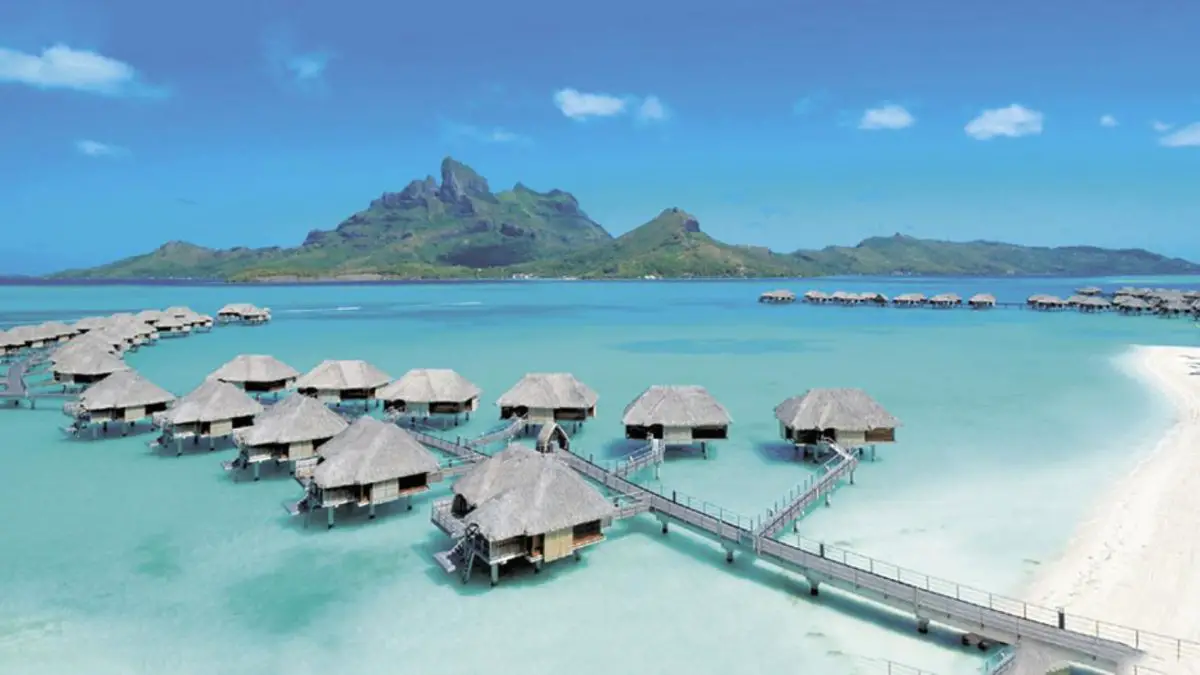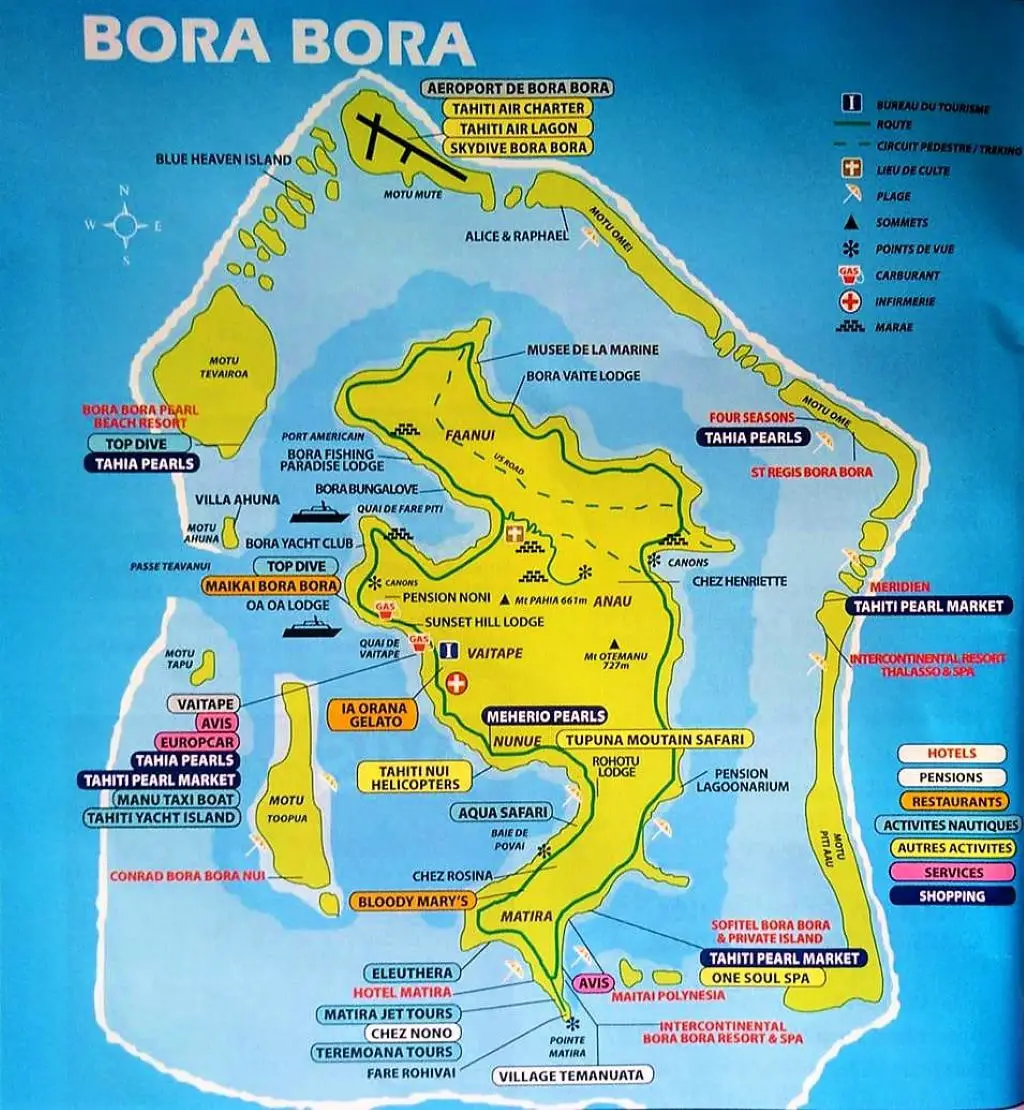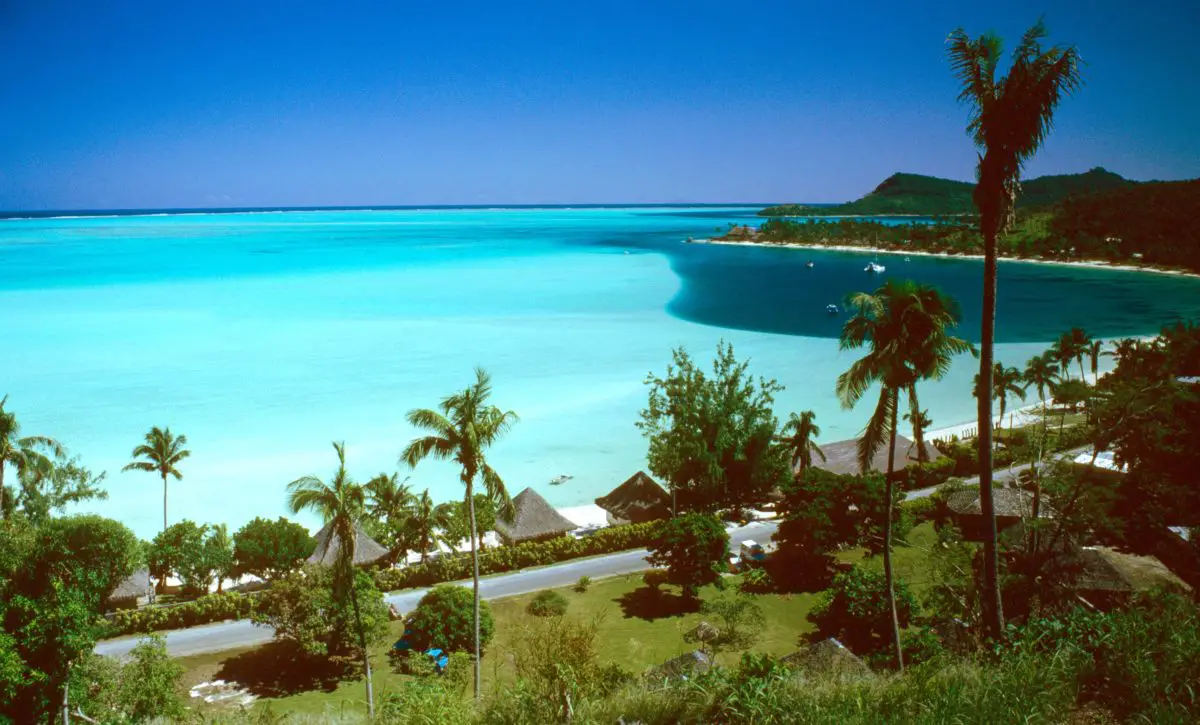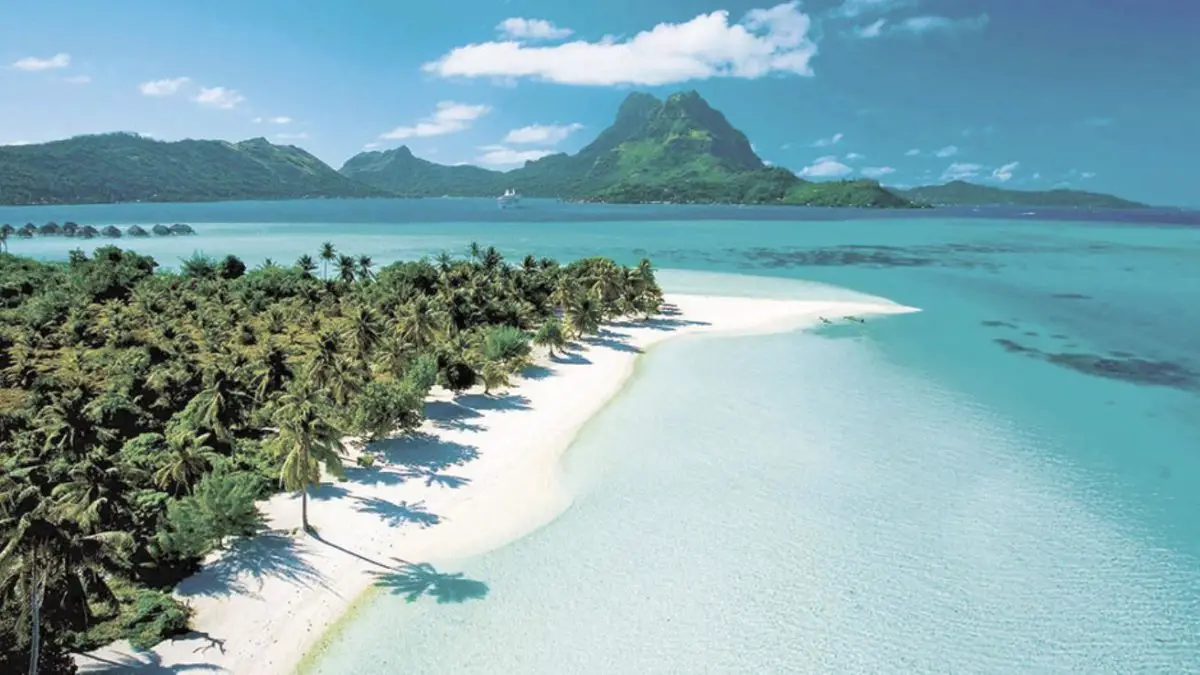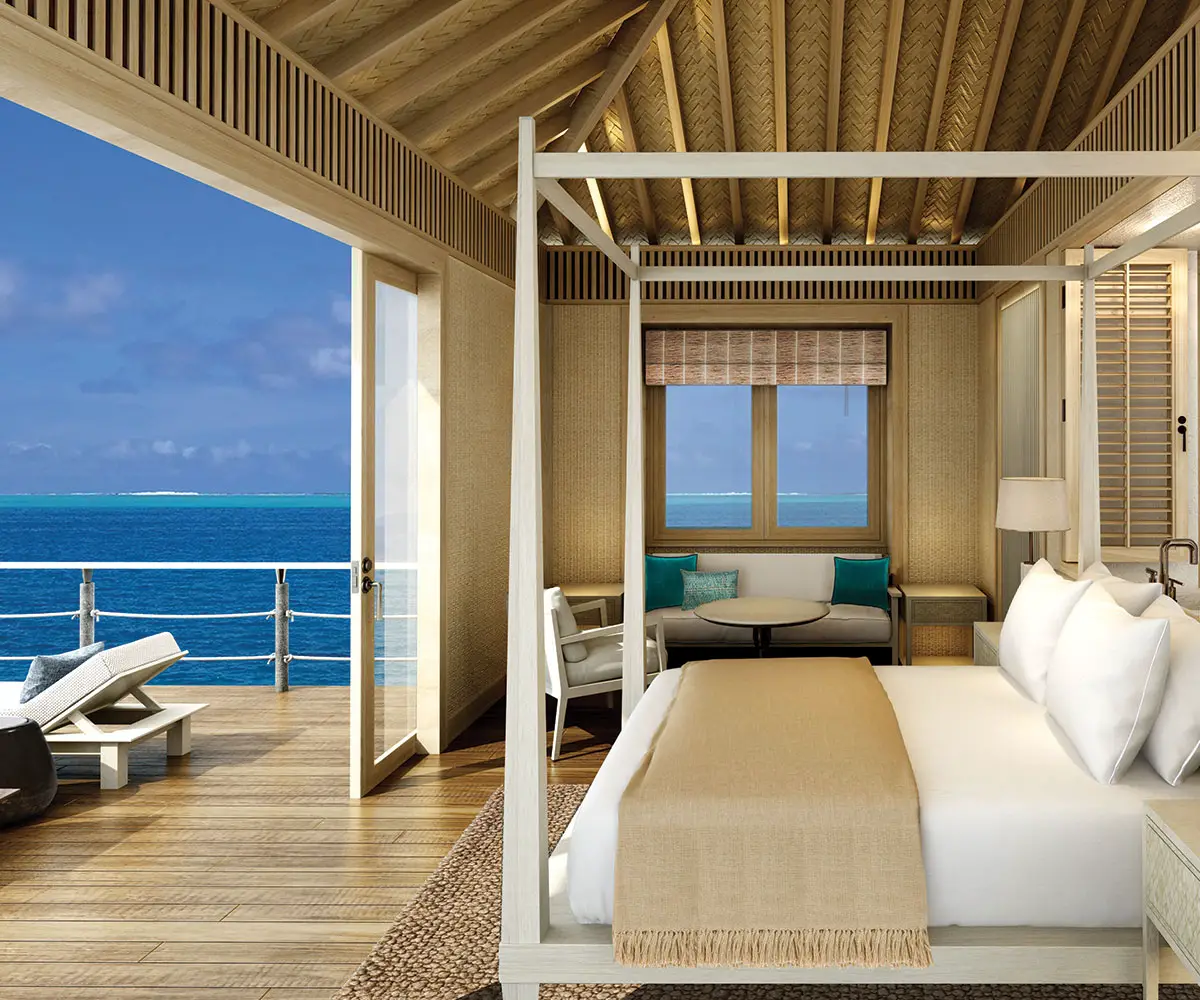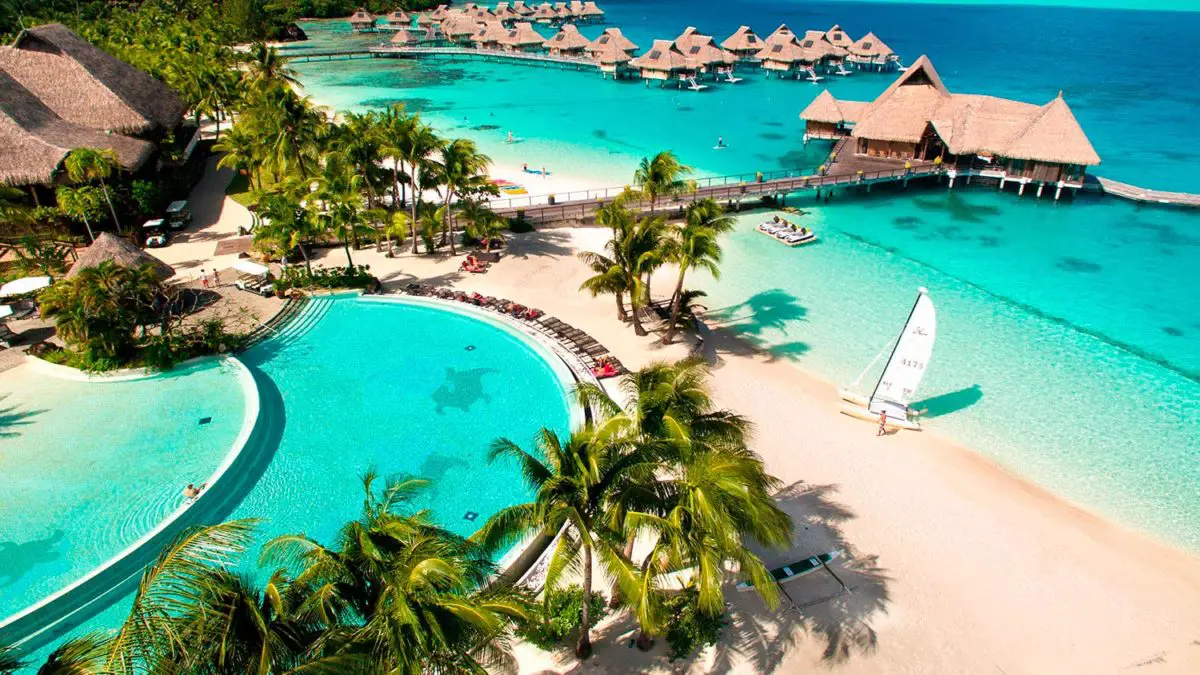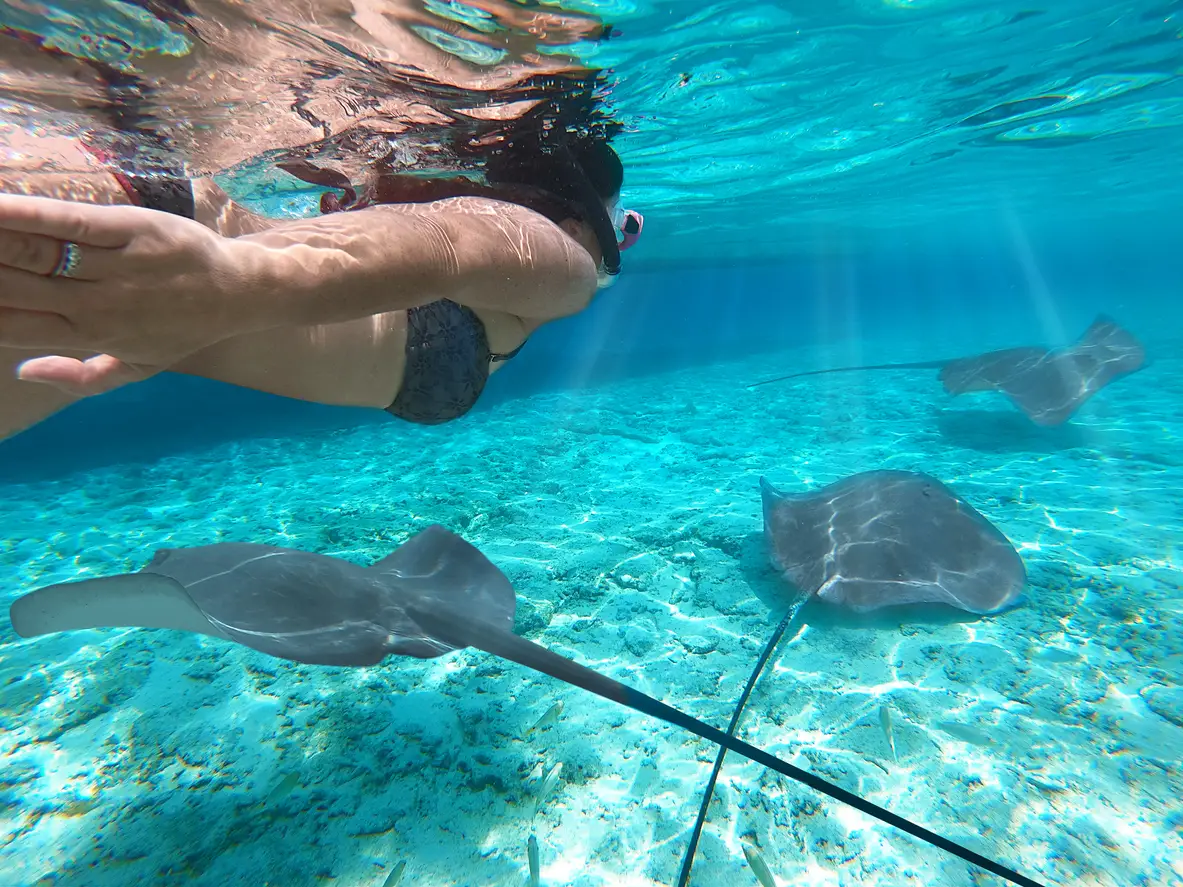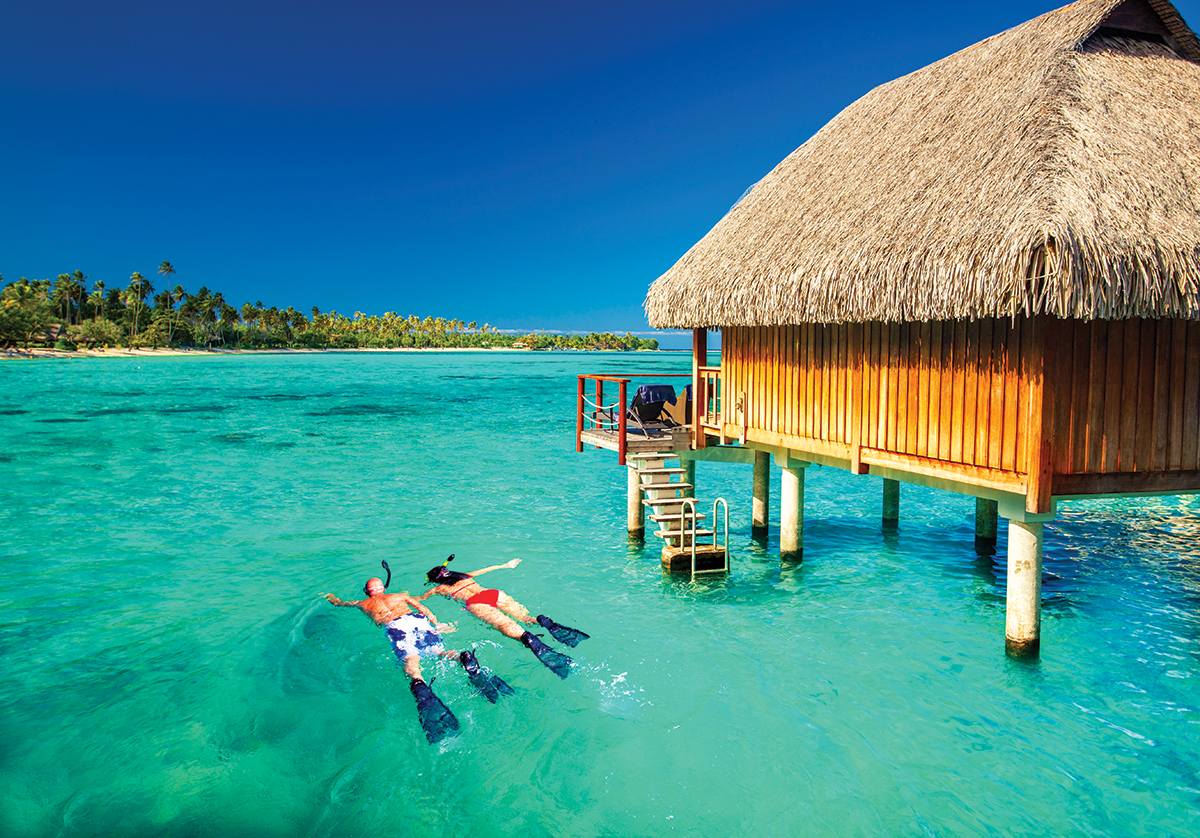The island of Bora Bora, located in the Pacific Ocean, is a tourist destination surrounded by white sandy beaches, crystal clear waters and a range of blue colours, its fauna and flora are classified as unique in the world, it has a warm climate all year round so there are no weather restrictions to visit it. Through this article, we invite you to know a little more about this special place that offers those who visit it peace and a direct communion with nature.
Indice De Contenido
Where is Bora Bora Island?
The island of Bora Bora is one of the many islands in the Society archipelago, Bora Bora means first born, the island is also known as May ti pora which means created by the gods. Located 260 km northwest of Tahiti, it is administratively part of the French Republic, so it is an overseas collectivity of French Polynesia, its dimensions are 29 km2, the capital is Vaitape, it has a population of 10,200 inhabitants and a population density of 302 inhabitants/km2.
This island has the characteristics of an atoll, as it is an island with a coral reef formation in the form of a ring surrounded by several islets, in the central area there is a mountain, the main island of Bora Bora measures 8 km long by 5 km wide, on the island there is an extinct volcano, the highest point is Mount Otemanu which is 227 metres high. There is no public transport on the island, so the only means of transport are rental cars, taxis and bicycles.
Why visit this island?
Visiting the island of Bora Bora is an unforgettable experience, it is a place where the natural aspect is present in all its elements, because besides its magnificent beaches that invite to relax and total enjoyment in its nightclubs, restaurants of first quality, you can also do any of these activities:
- Bora Bora Lagoonarium: This is an open-air aquarium where you can observe the island’s marine fauna and swim with sharks, dolphins and other sea creatures.
- Snorkelling: Bora Bora’s crystal clear beaches are ideal for all kinds of water sports, but snorkelling is the king of them all. You can see manta rays, eagle rays, sharks and a myriad of other marine life at a glance.
- Hiking: There are well-marked areas for hiking on the island, but if you prefer a more advanced level of adventure, you can hire the services of a hiking guide and enter the most secret and wonderful places on the island.
- 4X4 Safari: If you want to explore the interior of the island or visit Marae Fare-Opu, an altar surrounded by almost 4 metre high slabs with petroglyphs or symbols carved into the rock, this is the vehicle for you.
- The Amanahume viewpoint: It is located in the village of Nunui, when you get there you will find the marked trails, once at the viewpoint you will be able to observe the Povai bay, located to the southwest of the island, as well as the Mataorio bay, located to the southeast of the island.
- Touring the island by bike: This is an option that most tourists practice, the rental of the same can be for up to 24 consecutive hours, the same can be rented in the port, in the airport or in the hotel where you are staying, it is one of the most popular means of transport on the island.
Characteristics of its beaches
All the beaches of the island of Bora Bora, are a treasure of nature, all have white sand, crystalline waters, an ideal temperature all year round, in which you can appreciate at first sight its marine fauna, the beaches of the island are all calm, and this is because they are bordered by coral atolls that allow the natural lagoon to communicate with the sea. The island also has three bays that lead directly to the sea: Tuuraapuo Bay or Povai Bay to the west, Hitiaa Bay to the northwest and Tuuraapuo Bay, which separates the main island from Bora Bora by two volcanic islets, Toopua and Toopua-iti.
5 of Bora Bora’s best beaches
The beaches on the island of Bora Bora are spectacular and all have their own special charm, but if you find yourself on the island, we recommend you visit the following places:
Matira Beach
Matira Beach is a public beach and is located in the south of the island, it is considered one of the best beaches on the island of Bora Bora, it has 2 kilometres of coastline, its sands are white, the water is crystal clear so it produces different shades of turquoise blue, its waters are calm and shallow so it is suitable for diving, swimming, observing the corals and the great variety of fish.
Matira Beach stretches from the Bora Bora Hotel to Matira Point, when the tide is low you can walk across the lagoon to the coral reef; the town has the services of restaurants that can take you to the shore of the beach.
Beach at Four Seasons Resort Bora Bora
The beach at the Four Seasons Resort Bora Bora, is located on a private beach with a 5 star hotel, it is characterised by having bungalows which is a kind of cabin or small house with all the amenities, they are on the water, this beach is located in Motu Tehotu 6 kilometres from the capital Vaitape.
This resort offers all the services to its guests, the attention is personalised so you will feel like the king and queen of the place, the beaches of this resort are white and crystalline to enjoy all the water sports such as diving or kayaking, from the resort you can request the services for the different maritime or terrestrial tours, To get to know the island of Bora Bora better, you may prefer the infinity pool for refreshing drinks, spa treatments at the holistic healing centre for a moment of relaxation, restoration and rejuvenation of the body, and in the evenings you can enjoy the many restaurants and nightlife activities.
Beach at Conrad Bora Bora Nui
The beach at Conrad Bora Bora Nui, located 5 kilometres from Matira Beach and Motu Mute Airport on the island of Bora Bora, is a private beach on the Bora Bora lagoon overlooking the ocean and is home to a luxury resort with a 5-star hotel, The lagoon has two branches where the bungalows are located, which are connected by walkways and lead directly to the shore of the beach, which is characterised by white sand, crystal clear water and turquoise blue colour, on this beach you will find free services of non-motorised water sports such as pedal boats, kayaks and snorkelling equipment.
This luxurious resort offers all its clients all the services of quality, exclusivity and privacy, so guests will find comfortable rooms, personalised attention, a mini-golf course, gym, spa, discos and the best restaurants, among other services.
Beach at Bora Bora Pearl Beach Resort & Spa
Bora Bora Pearl Beach Resort & Spa is a 4-star luxury hotel with bungalows overlooking the lagoon, located in the Mount Otemanu area of Bora Bora Bora Island, on the shores of Motu Tevairoa Beach, 10 minutes by boat from Motu Mute Airport.
The beaches are white sandy, with crystal clear waters of various shades of blue, overlooking the natural lagoon where the coral garden is located and Mount Otemanu, on the beach you can count on sunbeds, umbrellas and hammocks that will allow you to relax completely while enjoying the breathtaking views that the place offers.
Visitors to the resort will find a full range of amenities including restaurants, bars, spa services, tennis courts, volleyball, basketball, mini golf, as well as complimentary stand-up paddle boarding, kayaks, canoes and snorkelling equipment, nightly shows and tour services both on land and at sea.
Beach at St Regis Bora Bora
The St. Regis Bora Bora Beach is a private beach located on a small island of Bora Bora, located 15 minutes by boat from the airport of Bora Bora and 20 minutes by car from the capital of Vaitape, the sand of its beaches are white and very soft, as well as the sea water is crystal clear and very calm, from the shore you can see Mount Otemanu, in the same there are free services of hammocks, paddle, kayaks, pedal boats and Hobie Cat which is a small sailing catamaran.
The luxury and personalised attention tourist complex offers the services of restaurant, bar, spa, gyms from its rooms and bungalows that are located on the coasts of the beach have panoramic views on the lagoon or on the nearby islands, the management of the tourist complex also puts at your disposal the services of free bicycle, for this it is necessary to make the corresponding reservations, also they have the service for the transfer to the island of Bora Bora.
Why is it a Blue Flag island?
The island of Bora Bora has been awarded the Blue Flag in 2012 and 2013, a distinction awarded annually since 1987 by the European Foundation for Environmental Education to beaches and harbours that meet four basic criteria, such as
- Bathing water quality.
- Environmental information and education.
- Environmental management and security.
- Services and facilities.
The island of Bora Bora has received this award five times in a row, most recently in 2012-2013, thanks to the efforts made by the local authorities in the field of water management in terms of: water desalination, waste water treatment both in the tourist area and in private households, environmental protection policies and plans, and the creation of the Sea Turtle Observation and Protection Centre.
The climate
The temperature in the hot season on the island of Bora Bora corresponds to the months of January to April with an average temperature of 30°C with an average minimum temperature of 26°C; for the cool season, which lasts from June to the beginning of September, the average temperature is 29°C with an average minimum temperature of 24°C.
The rainy season on the island of Bora Bora begins at the end of October and lasts until the beginning of May, with a 29% chance of precipitation. The dry season begins in early May and lasts until the end of October.
The windiest months are from May to mid-October with an average speed of 19 kilometres per hour, and the calmest months are from late October to May with an average speed of 17 kilometres per hour.
The warmest time of year is from January to early May with an average water temperature of 28°C, and the coldest time of year is from mid-July to mid-October with an average water temperature of 26°C.
The best time to visit Bora Bora is from June to the end of September, when the skies are clear and temperatures are pleasant.
Flora
The predominant vegetation is the tropical rain forest, which is presented with a dense forest or dense, this situation is due to the volcanic soil, which is very fertile, the warm temperature and the humidity factor present, among the vegetation that is located on the island of Bora Bora:
- Tropical forest: Coconut palms, the frutipan, the banana tree, the ceiba, the Pacific chestnut tree.
- Shrubs: Tiaré, hibiscus, plumeria, bougainvillea, gardenia, jasmine, etc. Fruits: mango, papaya, avocado, grapefruit, pineapple, orange, coconut, banana.
The fauna
The terrestrial fauna of the island of Bora Bora is rather poor, this situation is due to the remoteness of the island of Bora Bora from the mainland, so dogs, pigs, were introduced by the first Polynesian immigrants, horses and goats and horses were brought by the French in the eighteenth century.
Reptiles: This species is rare on the island, only the yellowish gecko is a type of lizard, there are no snakes on the island.
Insects: Mosquitoes, wasps, scolopendras, Marquesas, the nono (a very annoying species of mosquito).
Birds: Sea swallows, frigate birds, gannets, phaetons, among others.
Marine fauna: Corals, crabs, molluscs, sea urchins, lemon sharks, white fin sharks, black fin sharks, stingrays, manta rays, moray eels, groupers, surgeon fish, butterfly fish, parrot fish, stone fish, etc.
History of Bora Bora
The history of the island of Bora Bora begins with a legend that the first island in the ocean was Pora Pora and therefore the name was born first and that Bora Bora was the second island colonised after Havai’i, known as Raiatea, but there is no scientific evidence to support this legend, It is estimated that Bora Bora was born around 900 AD and that the first Polynesian settlers arrived in the same year, originally from the islands of Samoa or Tonga, located on the Oceania continent.
Studies indicate that the Austronesian migrations from South East Asia have the strongest support, as linguistic, biological and archaeological evidence shows that the languages of the Fijians, a population located on the continent of Oceania, and the Polynesian languages are of the same lineage. Migration is thought to have begun by sea, using dugout canoes to transport families and household goods.
In 1769, James Cook, a navigator, cartographer and captain in the British Royal Navy, found a 33-metre long boat in Tahiti that was propelled by oars and sails. In 2010, an expedition in a sailing dugout canoe from Tahiti to Asia was successfully completed. According to this theory, the first inhabitants of Bora Bora made their journey with their families, pets, animals for reproduction and food such as chickens, hens, pigs, plants for cultivation, etc. Archaeologists and historians claim that these early settlers were very skilled in the art of fishing and stone carving.
In the 18th century, the inhabitants of Bora Bora became a military and religious power, with rivalries between two clans, one of which was based in the Faanui area and grouped all the families of the neighbouring areas and practised the cult of the Polynesian gods of Farerua; and the second group dominated the families of the Nunue and Anau areas and their religious cult was directed towards Vaiotaha, the latter cult being one of the most prominent religious cults in Polynesia. These two groups often clashed in wars, a situation documented by the Dutch navigator Jakob Roggeveen in 1722 and confirmed by James Cook in his journals of 1769 and 1777.
In 1816, under the leadership of May, the inhabitants of Bora Bora were converted to Christianity, in 1822 Chief May drew up the first legal regulations for the island of Bora Bora, and in the same year the church opened its first headquarters in the capital, Vaitape. In 1831, the Queen of Tahiti separated from her husband, Tapoa II, who moved to Bora Bora and proclaimed himself king of the island with the approval of Chief May.
In 1842, the Tahitian monarchy ceded its territory to the French government, but the island of Bora Bora was not included in the French protectorate and ruled as an independent island by King Tapoa II until his death in 1860.
Tapoa II is succeeded on the throne by his daughter Teriimaevarua II, but in 1878 Germany tries to establish strategic and military alliances with the island of Bora Bora, this island is not interested in establishing alliances and informs the French government of Germany’s intentions, and France is not interested in a military installation near its overseas lands, because of this situation, the authorities represented by the chiefs of the clans and the queen of the island of Bora Bora asked France for a provisional protectorate. In 1887, France and England negotiated with other interests and the island of Bora Bora went from being an independent island to being a French protectorate; although the inhabitants of the former Kingdom of Tahiti were granted French citizenship, the inhabitants of Bora Bora were not granted French citizenship and remained under an indigenous regime.
During the Second World War, in 1942, the Americans set up a military base on the island of Bora Bora, during this period the Americans, in addition to carrying weapons of war, built roads, airstrips on the land surface and bases for hydro ships, naval ports, an electric power plant was installed, no battles took place on the island and in 1946 the military base was officially closed, But the Americans fell in love with the island, some of them stayed to live on the island and others returned as tourists, this situation opened the doors to economic development, but many of the inhabitants did not agree with the tourist development, since the construction of hotels was excessive and there was a loss of identity.
On 24 March 1945, the inhabitants of Bora Bora became French citizens. The first Paris-Bora Bora Bora flight took place in 1958, the first hotel was opened in the south of the island in 1972 and Bora Bora Bora became a French commune. At present, the construction of new tourist resorts is prohibited.
If you enjoyed this article, we invite you to visit the following links:
- Boracay Island
- Langkawi Island
- Marquesas Islands

